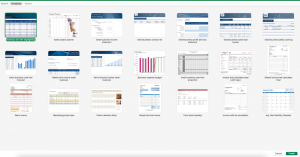Remote work naturally requires a baseline degree of independence among those who undertake it. Disciplined professionals, who are easily self-motivated, tend to perform best in telework settings.
But are there ways to encourage remote employees to become more independent; and, if so, how does increased self-sufficiency benefit businesses? The answer to both these questions is a resounding “Yes!”
The Advantages of Self-Sufficiency in Remote Workplaces
Greater independence in remote workplaces does not have to equal diminished oversight and productivity; in fact, the opposite is true. When employers with remote teams encourage self-sufficiency, employees feel valued. This factor alone contributes to increased job performance, motivation, wellness, and work-life integration among employees.
A survey conducted by Harris Interactive on behalf of the American Psychological Association (APA) found that “employees who feel valued are more likely to report better physical and mental health, as well as higher levels of engagement, satisfaction, and motivation, compared to those who do not feel valued by their employers.”
More than 1,700 adults were polled in the APA’s online survey. Among respondents, 93% felt compelled to do their best work when they also felt valued within their companies. Conversely, respondents who believed they were unappreciated by their employers cited a lack of influence in decision making and an absence of flex-work arrangements as primary factors for feeling devalued. Both negative impacts can be remedied through employer encouraged self-sufficiency via remote work.
3 Considerations for Assessing Remote Employee Independence
As remote leaders evaluate how to foster more self-sufficient work models among their distributed teams, they can utilize these questions and answers to discover how greater independence can be practically applied within their organizations.
1. Are there limits to autonomy in remote settings?
All remote jobs are not equally autonomous. Some telecommuting positions, such as telework nurse, virtual assistant, home-based accountant, and remote teacher, necessitate a high degree of reporting, adherence to regulations, and communication with supervisors, colleagues, and clients.
2. What tools can remote employees use to facilitate independence?
Leveraging digital resources to enable self-sufficiency in remote workplaces is the way forward. Thankfully, there is no shortage of remote team communication applications, like Slack, Asana, Zoom, Google Meet, Basecamp, and Microsoft Teams, to bridge geographical gaps in collaboration, manage projects, and ensure all employees remain informed and productive.
3. Should remote employees seeking more workplace freedom relay information early on in a project?
Proactive communication, which relates to early access to information and anticipating answers to questions that typically arise during project planning and development, should be a cornerstone of any workplace; however, it is essential to creating more independent telework environments. The good news is remote collaboration and communication tools, such as those mentioned above, make proactive communication methods accessible and efficient.
8 Steps Remote Leaders Can Take to Demonstrate Trust in Employees and Encourage Self-Sufficiency
Promoting increased independence within remote teams is one example of how leaders can exhibit trust in their workers. When employees recognize they are trusted by leaders, they are less likely to seek employment opportunities elsewhere—a boon for employers. Reduced turnover improves productivity consistency, workplace morale, and business expenses.
What’s more, an employee’s departure costs approximately 33% of that employee’s salary, according to the Society for Human Resource Management (SHRM). Reducing employee turnover by creating opportunities for professional freedom should be a priority for business leaders since SHRM also found that, in 2017 alone, 41 million workers voluntarily quit and as many as 47 million workers are expected to hand in their resignations by the end of 2020.
Demonstrating trust in employees and encouraging greater self-sufficiency among remote workers can be achieved through business strategies that maximize communication, responsibility, and effective management. The following eight steps toward improved telecommuting employee independence begin with remote-enabled leaders:
1. Model independence from the top by actively choosing to embody the growth, innovation, creativity, and positive workplace culture that leaders want to see emulated by their employees.
2. Pair responsibility with accountability to promote healthy workplace relationships, professional development, and better workflows.
3. Establish two-way communication channels within which thoughts, opinions, and feedback are given freely and respectfully. Actively welcoming, engaging with, and acting on employee feedback reinforces that workers are appreciated for their individuality, intelligence, and worth ethic rather than viewed as mere functional cogs serving to keep the business operational.
4. Delegate rather than micromanage employees, who will appreciate more opportunities to demonstrate their trustworthiness and value, which not only strengthens employee independence but also unburdens executive and managerial schedules.
5. Lead through questioning by utilizing open-ended as well as closed-ended questions, building rapport by requesting comments from employees and letting them know they have understanding from management, transferring situational ownership to employees as appropriate, and asking impact questions to identify current and future needs.
6. Embrace mentorship as an employee-driven approach to transitional self-sufficiency in new hires and green remote workers.
7. Accept that failures are inevitable and use them as teaching moments. Ask questions about what worked, what was not effective, how processes can improve in the future, and what employees need from management to be more successful.
8. Provide development opportunities and encourage employees to seize them. One of the best ways to support employee independence is to help them grow through experience, education, and training. In addition to supporting employees and their self-sufficiency, offering professional and personal growth avenues reinvests in the business. As employees learn and adopt more responsibilities, they will utilize their new knowledge, experience, and skillsets within the organization.
Employee Independence: A Win for All Involved
Encouraging remote employees to be more independent is a win for all involved. Company culture, employee engagement, productivity, growth and development, and workplace innovation all improve when employees are trusted to be more autonomous in their remote workplaces. Trusting telecommuting employees with greater responsibilities also reinforces their unique value within the workplace, and valued employees are loyal employees.
Business & Finance Articles on Business 2 Community
(66)






